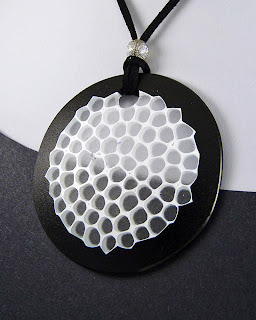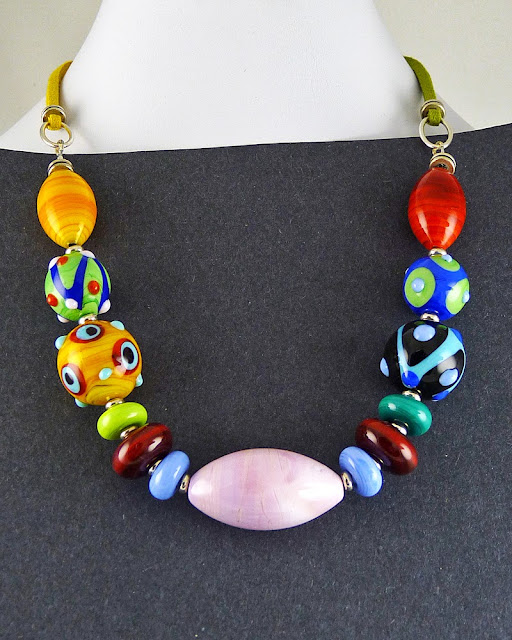It’s
not an easy task to find an authentic boutique carrying genuine collection, with
a knowledgeable owner who would be happy to chat with you about
traditional venetian bead making techniques and jewelry styles. If you
are in pursuit of a real deal it’s much
better to wander away from central sestiere
to Dorsoduro or Cannaregio, where in
times bygone glass makers worked, away from crowds, that’s where many sought after
treasures are hidden.


Glass
making for centuries was so vitally important
for venetian wealth and glory
that it actually became a synonym: Venice – sea – glass…
The
early glass artifacts found there were attributed to 4th-7th centuries. By
12th there was a guild of glass artisans and in 13th century the glass blowing was an established industry and due to high
fire risk was moved forever to the island of Murano. By mid 14th century prosperous
city-state, without any natural resources needed for glass blowing, became a
unique glass producing capital of the world.
The
finest sand for the venetian crystal masterpieces
was imported from Syria and later from Fontainebleau in France.
However,
did you know that Venice was the first to manufacture mirrors since 15th
century and by 17th Murano masters could produce the largest mirrors
in the world?
At
this time Venice so favored all sorts of goods displays that she was the first to install large glass
shop windows dressed with special
artistic care.
Vases,
chalices, goblets, bowls, chandeliers, crystal stemware, lamps, mirrors, window
glass, eye-glasses, elaborate luxury objects and of course mosaics and at last
beads – this is where Venice became an unsurpassed leader by 17th
century.
In
fact beads for jewelry making and skillful faux gemstones brought the
fortune to the state of Venice. If it
wasn’t Alexandre Dumas who coined “Cherchez la femme” it should be venetians to
say “cerca la donna” as this ornamental
industry remains the most flourishing up to our days.

The
problem is that low key Murano jewelry is sold everywhere in Venice and you
have to search thoroughly to find something special. The other problem is that myriad
of ready to wear sets are made in
traditional styles (I already have a few in my collection), but I was looking
for something exquisite , contemporary
Murano loose glass beads or a pendant where tradition comes alive in modern
design.
And
I’ve got lucky! In Cannaregio on La
Strada Nuova there was MY boutique : elegantly designed interior, exclusive gallery
style display in the window, the silver haired owner looked like Franco Nero,
friendly smile. It wasn’t just a boutique, it was a museum of Murano jewelry as
there were authentic antique Murina pieces on display with astronomic prices
attached of course. Seeing my genuine interest (though I mentioned right away that
I can only enjoy and appreciate the beauty) he started to open the locked
drawers where on the velvet trays were laid out
unbelievably beautiful (and unapproachable) necklaces and beads made up
to a hundred years ago by famous glass makers. Wonderful colorful examples of
various techniques. Live tradition in
its very best. The owner insisted I should at least try a necklace, irresistible
temptation… A sigh...
And when I was about to leave with heartfelt
thanks he showed me a tacked away small contemporary
collection and very unusual pendant
nobody was interested in and that was it.
Exactly
what I was looking for (and affordable too)!
The
image doesn’t do the justice. It’s even more beautiful and exquisite.


Very unusual honeycomb technique. It's more like a coral in glass.
Just
a few steps into history of Murano glass jewelry making.
The
first glass beads appeared in early 14th century were skillful
imitation of precious gems. They were cut and faceted and soon became and important trade commodity. Various
techniques emerged, variable palette introduced and patterns developed to stay in use since then.
Beads
were translucent and opaque, more colors were added to the molten glass and stretched into a cane which was later cut into bead
size pieces. That’s in short how Chevron and Rosetta techniques were invented.
In fact since 1600s the tiniest Conterie beads for embroidery and colorful Rosetta
beads were in such a high demand and
highly valued especially in colonial lands and Africa that they were used as a currency and got the name trade beads.
Naturally
Venice regarded and guarded the glassmaking secrets as the top state secrets. Stealing
or disclosing manufacturing secrets or even run away was considered a crime against the state, the
worst of all in Venitian law system and the
shortest way to a death penalty.
The
most famous bead technique is Millefiori
“a thousand flowers”. It still is the most popular technique widely used in jewelry and decorative objects making.
Beside
the heavy solid glass beads there are blown glass beads much lighter, in
endless shapes and color combinations. Extremely fragile tiny masterpieces.
There
are gold, silver or copper foil intrusions in glass which produce stunning
shimmering effects. Popular for pendants and candy size beads called Caramella for that matter.
And
the last to name a few are Lamp work beads, each individually made and
decorated with colorful applique in traditional ornamental patterns.

This
a very brief history of Venetian glass beads.
One
can’t get enough of watching this glittering and mesmerizing glass sea reflecting glorious palazzi and a sea of glass
reflecting all of this incredible beauty.
This contemporary piece inspired by Murano pendant I designed with lava rondelle.
More details or to buy here
Have a wonderful weekend my friends.
All images © Natalie Rapoport









